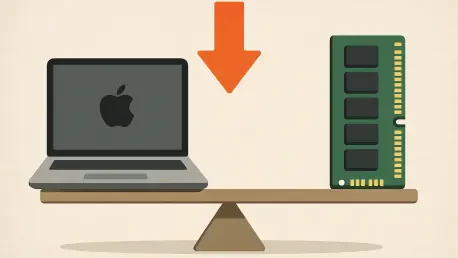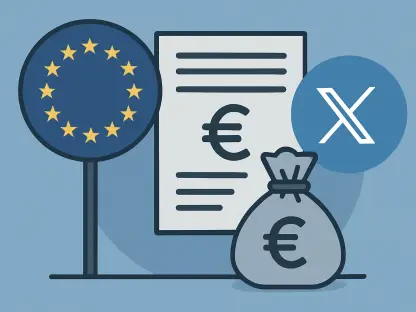In an industry increasingly defined by artificial intelligence (AI), a staggering statistic underscores a critical challenge: memory prices have surged by as much as 60% for certain types, driven by the voracious demands of AI infrastructure. This dramatic escalation in RAM costs is not just a fleeting concern but a transformative force reshaping the personal computer (PC) market. As manufacturers grapple with supply shortages and escalating expenses, buyers—both individual and enterprise—are forced to reevaluate their hardware investments. This market analysis delves into the dynamics of rising RAM prices, exploring how these pressures might position Apple as a compelling choice amid the volatility. By examining current trends, data, and strategic advantages, the goal is to provide actionable insights for IT decision-makers navigating this costly landscape.
In-Depth Market Trends and Projections
The Driving Force: AI’s Insatiable Appetite for Memory
The root of the current RAM crisis lies in the unprecedented growth of AI applications, from generative models to cloud-based analytics, which demand vast amounts of high-bandwidth memory. Major suppliers have reported significant supply constraints as AI infrastructure consumes resources at an alarming rate, pushing prices upward across the supply chain. This trend shows no sign of abating, with industry forecasts indicating that memory demand will continue to climb through at least 2027, potentially exacerbating shortages. Unlike past market cycles where price fluctuations were tied to consumer trends like gaming, today’s surge impacts every segment, from budget devices to enterprise-grade workstations. This broad effect signals a structural shift in the industry, where memory is no longer just a component but a critical bottleneck influencing hardware design and cost structures.
Impact on PC Vendors: A Disparity in Vulnerability
Rising RAM costs are hitting PC manufacturers unevenly, creating a clear divide in market resilience. Smaller vendors and traditional players like Dell and HP face immediate challenges, with analysts downgrading their stocks due to exposure to price volatility and supply chain disruptions. These companies often lack the scale to secure components at favorable rates, leading to higher costs that are inevitably passed on to consumers. Projections suggest that without strategic adaptations, such as diversifying suppliers or rethinking memory architectures, these vendors could see shrinking margins over the next two years. The financial strain is compounded by the need to increase RAM capacities in devices to meet AI-driven performance expectations, further inflating production expenses and retail prices.
Apple’s Strategic Positioning: Efficiency as a Competitive Lever
Amid this turmoil, Apple stands out with a distinct advantage rooted in its unified memory architecture and system integration. By embedding memory directly with its Apple Silicon processors, the company achieves remarkable efficiency, often delivering superior performance with less RAM compared to competitors. Benchmarks reveal that a Mac with 8GB of memory can match or exceed a Windows laptop with double that capacity, a factor that becomes increasingly significant as memory prices soar. While this design limits upgradeability—a potential drawback for some buyers—it translates to lower energy consumption and reduced long-term costs, positioning Apple favorably in a market where operational expenses are under scrutiny. Market analysis suggests that this efficiency could solidify Apple’s appeal, particularly for enterprises focused on sustainability and budget predictability.
Bulk Purchasing Power: A Buffer Against Volatility
Another pillar of Apple’s market strength is its ability to procure components in massive volumes, a capability that shields it from the worst of the price spikes affecting smaller competitors. This bulk buying power enables more stable pricing for end users, a critical advantage when other vendors are forced to adjust costs reactively. Although no company is entirely immune to prolonged scarcity, Apple’s strategic stockpiling and supplier negotiations provide a temporary cushion that could last through current market turbulence. Data from industry reports indicate that this approach may allow Apple to maintain competitive pricing for at least the next 12-18 months, offering a window of opportunity for buyers seeking cost certainty in an unpredictable environment.
Enterprise Dynamics: Shifting Focus to Total Cost of Ownership
For enterprise buyers, the RAM price surge amplifies existing challenges, including the obsolescence of millions of PCs incompatible with modern operating systems like Windows 11. This compatibility crisis, combined with higher hardware and energy costs, pushes total cost of ownership (TCO) to the forefront of purchasing decisions. Apple’s ecosystem, despite its premium entry price, often delivers savings through longer device lifespans, lower power usage, and robust security features. Market trends point to growing interest among IT departments in platforms that balance upfront investment with operational efficiency, especially in regions with high electricity costs. However, adoption barriers persist in markets tied to Windows-based workflows, suggesting that Apple’s enterprise growth will depend on targeted education about TCO benefits over the coming years.
Future Outlook: Memory Demand and Industry Evolution
Looking ahead, the trajectory of RAM prices remains tied to AI’s unrelenting expansion, with projections estimating sustained demand growth as AI tools permeate consumer and business applications. Technological advancements, such as next-generation memory standards, may eventually ease cost pressures, but widespread adoption is likely years away. Economic risks, including a potential correction in AI investment, could further disrupt supply chains, adding uncertainty to market forecasts. Regulatory factors, such as restrictions on energy-intensive technologies, might also reshape manufacturer priorities, pushing toward more efficient designs. In this fluid landscape, Apple’s focus on integration and performance per watt is expected to maintain its edge, though competitors could narrow the gap if open standards for AI hardware gain traction in the near term.
Reflecting on the Market Shifts: Strategic Takeaways
Looking back, this analysis revealed how the surge in RAM prices, fueled by AI’s resource demands, reshaped the PC market, creating both challenges and opportunities for vendors and buyers alike. Apple’s unique strengths—unified memory efficiency, bulk purchasing power, and a compelling TCO for enterprises—positioned it as a standout option amid the volatility. For IT leaders and individual consumers navigating this environment, the next steps involve prioritizing devices that optimize performance per watt and evaluating long-term costs over initial price tags. Strategic planning could include phased transitions to ecosystems offering stability and efficiency, particularly for organizations facing Windows obsolescence. Additionally, staying attuned to emerging memory technologies and regulatory shifts offers a proactive way to mitigate future cost pressures. These actionable considerations provide a roadmap for smarter hardware investments in a memory-constrained era.









